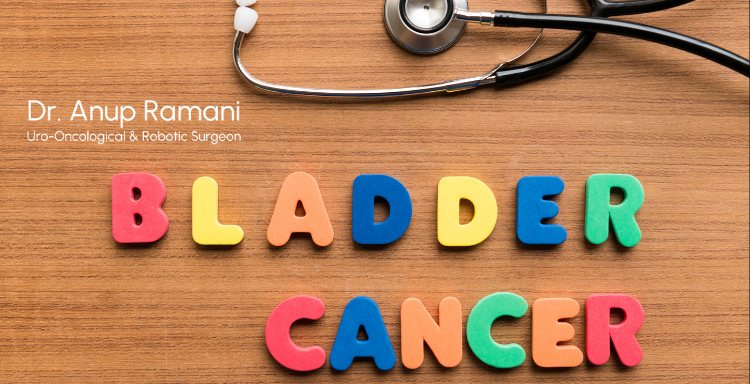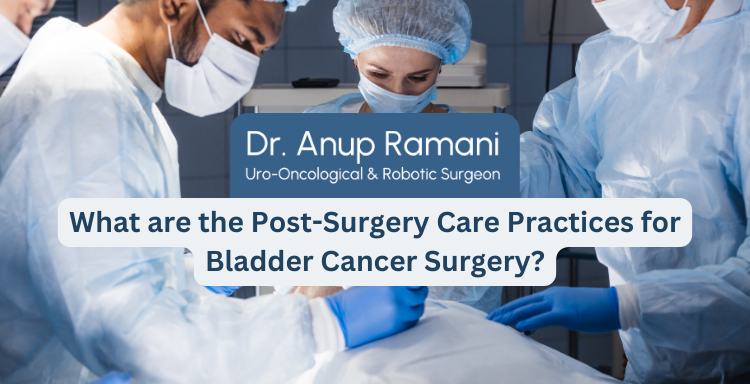Dr Anup Ramani @ Copyright 2024
By Dr. Anup Ramani
Bladder cancer surgery is a life-changing procedure that requires significant post-operative care to ensure a smooth and healthy recovery. Whether the surgery involves tumor removal, partial bladder removal or a radical cystectomy, patients must adhere to specific care practices to prevent complications and regain strength.
In this article, we will discuss about the best practices for managing post-surgery recovery, maintaining physical and emotional well-being and adjusting to any lifestyle changes.

1. Managing Pain and Discomfort
Pain and discomfort are common after bladder cancer surgery, especially in the abdominal area or around the surgical sites. Proper management ensures comfort and promotes healing.
- Follow the prescribed medications: Pain relief medications will be provided by your doctor. Always take them as directed and never exceed the recommended dose. Avoid over-the-counter painkillers unless explicitly approved by your surgeon.
- Consider alternative pain management techniques: Alongside medications, techniques like meditation, deep breathing exercises or even guided relaxation videos can help ease the mind and body.
- Contact your doctor for severe pain: While discomfort is expected, sharp or unusual pain might indicate complications. Always consult your healthcare provider if pain persists or worsens.
2. Caring for Surgical Drains and Catheters
After bladder cancer treatment, surgical drains and urinary catheters are often inserted to manage bodily fluids and allow healing. Learning how to care for these devices is crucial.
- Clean the catheter and drain areas: Use sterile gauze and antiseptic solutions to clean the areas daily. Keeping the sites clean prevents infections.
- Empty catheter bags regularly: Follow your doctor’s instructions on when and how to empty the urinary bag. This helps avoid overflow or infections.
- Look for signs of infection: Pay attention to symptoms like redness, swelling, warmth around the site or unusual discharge. Contact your doctor immediately if any of these occur.
- Handle devices gently: Ensure catheters and drain pipes are not pulled or twisted during movement to prevent complications.
3. Gradual Resumption of Diet
Post-surgery, patients are typically kept nil by mouth for several days. This allows the digestive system and urinary tract to recover. Gradually reintroducing foods into your diet is an essential part of the healing process.
- Start with liquids: Once cleared by your doctor, begin with clear fluids like water, broths or herbal teas. Gradually progress to soft, easily digestible foods like yogurt, mashed potatoes or soups.
- Avoid heavy or spicy foods: Foods that are too rich, spicy or acidic can irritate the stomach and bladder during recovery.
- Stay hydrated: Drink plenty of water to keep your system functioning properly and prevent urinary infections.
- Introduce solid foods gradually: Over time, reintroduce a balanced diet, including fruits, vegetables, lean proteins and whole grains to support healing.
4. Monitoring for Post-Surgical Complications
Post-surgery, complications can arise if proper care isn’t taken. Knowing the warning signs ensures early intervention.
- Watch for urinary infections: Symptoms include burning sensations during urination, foul-smelling urine or cloudy urine. Report these to your doctor immediately.
- Inspect surgical wounds regularly: Look for signs of redness, swelling, unusual discharge or persistent bleeding. Keeping wounds clean and dry helps prevent infections.
- Be mindful of bowel irregularities: Some patients may experience constipation or diarrhea post-surgery. Consult your doctor for dietary adjustments or medications to address these issues.
5. Physical Activity and Mobility
Staying physically active after surgery can improve circulation, speed up recovery and prevent complications like blood clots. However, it’s essential to balance movement with rest.
- Begin with light activities: Short, slow walks around your home can improve circulation and reduce stiffness. Avoid prolonged sitting or lying down.
- Avoid Challenging activities: Activities like heavy lifting, running or bending should be avoided for at least two months post-surgery. Overexertion can stress surgical sites.
- Use support if needed: If walking independently is challenging, consider using a walker or cane to assist with mobility.
- Gradually increase activity: As you gain strength, gradually increase your walking time or light exercises, always with your doctor’s approval.
6. Emotional and Mental Health Support
Undergoing bladder cancer surgery is not just a physical challenge – it can be emotionally overwhelming. Patients may feel anxiety, fear or sadness during recovery. Addressing these emotions is an essential part of the healing process.
- Consider therapy or counselling: Speaking with a mental health professional can help you process emotions and adjust to life after surgery.
- Join support groups: Many patients find comfort in connecting with others who have undergone similar experiences. Sharing stories and tips can be empowering.
- Focus on self-care: Engage in activities that bring joy, such as reading, journaling or practicing mindfulness.
- Communicate with loved ones: Let family and friends know how they can support you emotionally and physically.
7. Adopting a Healthy Lifestyle
Your overall health plays a significant role in your post-surgery recovery and long-term well-being. Making lifestyle adjustments can reduce the risk of complications and improve your quality of life.
- Quit smoking: Smoking can delay healing and increase the risk of bladder cancer recurrence. Seek support to quit permanently.
- Maintain a balanced diet: Focus on nutrient-rich foods to aid in recovery. Include leafy greens, lean proteins and whole grains to strengthen your immune system.
- Stay hydrated: Drink enough water to promote bladder and kidney health. Proper hydration also prevents urinary tract infections.
- Avoid alcohol: Alcohol can irritate the bladder and should be avoided during the recovery period.
8. Follow-Up Care
Regular follow-ups are a critical part of recovery. They allow your healthcare team to monitor your progress, check for any signs of recurrence and ensure your recovery is on track.
- Attend scheduled appointments: Follow-up visits often include physical exams, imaging tests like CT scans and discussions about any ongoing concerns.
- Stick to the plan: Your doctor may recommend yearly scans or blood tests for several years to monitor your health. Adhere to this schedule diligently.
- Communicate any changes: Inform your healthcare provider about any unusual symptoms or challenges you experience during recovery.
9. Adjusting to Lifestyle Changes
Patients who’ve undergone radical cystectomy with bladder removal may face significant lifestyle changes, such as living with a stoma or urinary diversion. While these changes can feel overwhelming, many patients adapt successfully over time.
- Learn stoma care techniques: Your healthcare team will provide training on managing and cleaning the stoma or urinary diversion system.
- Seek professional guidance: A stoma nurse can offer ongoing support and answer questions about daily care.
- Take it one day at a time: Adjusting to these changes takes patience and practice. Celebrate small milestones in your journey.
10. Returning to Work and Routine Activities
Most patients can return to their normal activities, including work, within a few weeks to months, depending on the nature of the surgery and job requirements.
- Discuss timelines with your doctor: Your healthcare provider will guide you on when it’s safe to return to work or resume specific tasks.
- Start with light activities: Avoid physically demanding tasks until you have fully regained your strength.
- Listen to your body: If you feel tired or experience discomfort, take breaks and rest. Recovery is a gradual process.
Conclusion
Recovering from bladder cancer surgery requires a combination of proper medical care, a supportive environment and personal dedication. Following these detailed tips will help ensure a smoother recovery, minimize complications and improve your overall quality of life. Remember, every patient’s journey is unique, so it’s essential to work closely with your healthcare provider to tailor your post-operative care plan.
FAQs About Bladder Cancer Surgery
1. How long does it take to fully recover from bladder cancer surgery?
Most patients feel better within six weeks, but full recovery, especially after radical cystectomy, can take up to three months or longer.
2. What dietary precautions should I follow after bladder surgery?
Stick to a liquid diet initially and gradually reintroduce solid foods. Avoid spicy, acidic or processed foods during recovery.
3. Can I exercise after surgery?
Light exercises like walking are encouraged, but avoid strenuous activities like heavy lifting for at least two months or as advised by your doctor.
4. How do I prevent infections after surgery?
Keep surgical sites clean, maintain good hygiene and report any signs of infection, such as redness, swelling or fever, to your doctor promptly.
5. Is it normal to feel emotional distress after bladder cancer surgery?
Yes, emotional distress is common. Seeking therapy, joining support groups or talking with loved ones can help you cope effectively.
About Author

Uro-Oncological & Robotic Surgeon
Dr. Anup Ramani is a robotic uro-oncological surgeon and an internationally recognized expert in robotic surgery for prostate, kidney and urinary bladder cancers. With more than two decades of robotic experience and 2,000+ robotic procedures, he brings unmatched precision and outcomes to complex uro-oncology cases. He is widely published in his field and is known for a personal, transparent approach-often spending over an hour in initial consultations to educate patients on its disease, surgery and recovery. His expertise spans prostate cancer treatment, kidney and bladder cancer surgery, adrenal gland surgery, kidney stone treatment, penile cancer surgery and enlarged prostate management. Dr. Ramani advocates the advantages of robotic surgery-magnified 3D vision, tremor-filtered precision, minimal scarring, lower blood loss and faster recovery-helping patients return to life sooner.
Table of Contents
Recent Blogs
Best Uro-Oncological surgeon
Specialist in India for Robotic Surgery
MCh, DNB, MS, DNB
Dr. Anup Ramani
CONTACT
Uro-Oncologist in India,
Best Robotic Surgeon for Uro Oncology Surgery
1407, One Lodha Place Next to World Towers Senapati Bapat Marg, Worli, Mumbai. 400013.
Dr Anup Ramani @ Copyright 2024 – Website Maintenance, SEO & GEO by Opal Infotech
- Partial penectomy is done in cases where glans and distal penis is involved with carcinoma.
- Partial penectomy is a type of organ-preserving surgery. Preservation of sexual and micturational function depends on the surgical dissection and reconstruction of residual urethra.
- Patients who develop stones in the kidney or ureter, often experience severe pain.
- This condition usually needs a procedure to remove the kidney stones.
- This procedure is called ureteroscopy and is performed very commonly.
- It does not require any cuts and hence it is painless.
- The procedure is performed with an endoscope inserted through the penis under spinal anesthesia.
- The scope is inserted through the penis into the kidney and stones are dissolved with a laser.
- The procedure takes about 40-50 minutes.
- A catheter (urine pipe) is kept after the procedure to drain the bladder. A stent is kept in the kidney at the same time.
- Patient is mobile and walking in the room the same evening.
- Hospital stay is one night and patient is discharged the next day after removal of the catheter.
- Patient has to come back after six weeks to remove the stent in the kidney.
- Patients can resume office a week after surgery and heavy activities like running, weight lifting, a month after the procedure.
- We offer fixed packages for this procedure which can be obtained by calling our helpline +91 9967666060.
- Men with an enlarged prostate, which is a normal ageing changes, often experiencing difficulty passing urine. This condition usually needs a procedure to trim the prostate and relieve the blockage.
- This procedure is called TURP and is performed very commonly.
- It does not require any cuts and hence it is painless.
- The procedure is performed with an endoscope inserted through the penis under spinal anaesthesia.
- The overgrown prostate is dissolved with a laser bloodlessly.
- The procedure takes about 40 minutes.
- A catheter (urine pipe) is kept after the procedure to drain the bladder.
- Patient is mobile and walking in the room the same evening.
- Hospital stay is two nights and patient is discharged with the catheter, which is removed after 4 days.
- Patients can resume office a week after surgery and heavy activities like running, weight lifting, a month after the procedure.
- We offer fixed packages for this procedure which can be obtained by calling our helpline +91 9967666060.
-
Robotic adrenalectomy is a sophisticated, complex surgery and it is very important that an experienced surgeon performs this surgery to avoid major complications.
-
Once the anesthesia is done, and patient positioned, three micro cuts (3mm each) are made in the patient’s abdomen.
-
The arms of the Da Vinci robot are connected to the cuts via ports (tubes).
-
Dr. Ramani then sits in the controlling console to perform the surgery.
-
On an average, a robotic adrenalectomy takes one hour.
-
The surgery is almost completely bloodless and there has never been any need to transfuse blood after surgery.
-
A urine catheter and bag to drain the bladder is inserted during surgery.
-
A tiny drain pipe may be inserted in the surgical side of the abdomen, connected to a bag.
-
Patient is kept nil-by-mouth the day of the surgery, with IV fluids. Sips of water are started the next day and solid food by day three.
-
The drain pipe, if kept, is removed in the room on day 2 after surgery.
-
The catheter is removed on day two after surgery.
-
Total hospital stay for robotic adrenalectomy is 4 nights (including night before surgery).
-
Post discharge, a doctor from the surgical team visits the patient at home/ hotel room once every day.
On the day of discharge, patient is totally self-sufficient. They are able to walk freely without any pain, dress themselves, shower, toilet and they do not need to hire any nurse or help at home. Almost all patients are back to work within 2 weeks of surgery.
Heavy activities like running, weight lifting can be resumed after a month
Follow up after an adrenalectomy is in the form of CT scans, once a year for 5 years.
Local patients usually meet Dr. Ramani after two weeks to discuss report.Outstation patients are counselled on a phone consultation.
- Dr. Ramani is one of the very few surgeons in India who has the expertise to perform a robotic surgery for bladder cancer, which includes removing the urinary bladder and reconstructing a new bladder robotically.
- Robotic radical cystectomy is an extremely sophisticated, complex surgery and it is very important that an experienced surgeon performs this surgery to avoid major complications.
- Once the anaesthesia is done, and patient positioned, six micro cuts (3mm each) are made in the patient’s abdomen.
- The arms of the Da Vinci robot are connected to the cuts via ports (tubes).
- Dr. Ramani then sits in the controlling console to perform the surgery.
- On an average, a robotic radical cystectomy with an ileal conduit takes 3-4 hours.
- The surgery is almost completely bloodless and there has never been any need to transfuse blood after surgery.
- A urine catheter and bag to drain the new bladder is inserted during surgery.
- Two tiny drain pipe in inserted in the surgical side of the abdomen, connected to a bag.
- Patient is kept nil-by-mouth for 4 days after surgery with IV supplementation of patient’s daily requirements of calories, fats, carbohydrates, proteins and electrolytes.
- The drain pipes are removed in the room on day 3-5 after surgery.
- Total hospital stay for radical cystectomy is 8 nights (including night before surgery).
- Post discharge, a doctor from the surgical team visits the patient at home/ hotel room once every day.
- On the day of discharge, patient is totally self-sufficient. They are able to walk freely without any pain, dress themselves, shower, toilet and they do not need to hire any nurse or help at home.
- Almost all patients are back to work within 6 weeks of surgery. Heavy activities like running, weight lifting can be resumed after two months.
Follow up after a radical a cystectomy is in the form of CT scans, once a year for 5 years.
Histopathology report: Local patients usually meet Dr. Ramani after two weeks to discuss report.
Outstation patients are counselled on a phone consult. Depending on the report, patient may or may not need chemotherapy after surgery.
If chemo is needed, patients may choose to get it done with a medical oncologist of their choice or avail the services of one of the four medical oncologists on our team.
- Robotic partial nephrectomy is a sophisticated, complex surgery and it is very important that an experienced surgeon performs this surgery to avoid major complications. Robotic radical (total) nephrectomy is
- relatively easier but still requires significant experience to consistently deliver results.
- Once the anaesthesia is done, and patient positioned, five micro cuts (3mm each) are made in the patient’s abdomen.
- The arms of the Da Vinci robot are connected to the cuts via ports (tubes).
- Dr. Ramani then sits in the controlling console to perform the surgery.
- On an average, a robotic radical nephrectomy takes one hour and a robotic partial nephrectomy takes about an hour and half.
- The surgery is almost completely bloodless and there has never been any need to transfuse blood after surgery.
- A urine catheter and bag to drain the bladder is inserted during surgery.
- A tiny drain pipe in inserted in the surgical side of the abdomen, connected to a bag.
- Patient is kept nil-by-mouth the day of the surgery, with IV fluids. Sips of water are started the next day and solid food by day three.
- The drain pipe is removed in the room on day 3 after surgery. The catheter is removed on day two after surgery.
- Total hospital stay for radical/partial nephrectomy is 4 nights (including night before surgery).
- Post discharge, a doctor from the surgical team visits the patient at home/ hotel room once every day.
- On the day of discharge, patient is totally self- sufficient.
- They are able to walk freely without any pain, dress themselves, shower, toilet and they do not need to hire any nurse or help at home.
- Almost all patients are back to work within 2-3 weeks of surgery.
- Heavy activities like running, weight lifting can be resumed after a month.
- Follow up after a radical/partial Nephrectomy is in the form of CT scans, once a year for 5 years.
- Local patients usually meet Dr. Ramani after two weeks to discuss report.
- Outstation patients are counselled on a phone consultation.







